Utilization of the Maryland Environmental Justice Screening Tool: A Bladensburg, Maryland Case Study
Abstract
1. Introduction
2. Materials and Methods
3. Results
3.1. Scoring Process
3.2. Comparison of MD EJSCREEN to CalEnviroScreen and EPA EJSCREEN
3.3. Bladensburg: A Case Study
4. Discussion
5. Conclusions
Author Contributions
Funding
Acknowledgments
Conflicts of Interest
References
- Adamkiewicz, G.; Spengler, J.D.; Harley, A.E.; Stoddard, A.; Yang, M.; Alvarez-Reeves, M.; Sorensen, G. Environmental conditions in low-income urban housing: Clustering and associations with self-reported health. Am. J. Public Health 2014, 104, 1650–1656. [Google Scholar] [CrossRef]
- Koester, S.; Davis, S. Siting of Wood Pellet Production Facilities in Environmental Justice Communities in the Southeastern United States. Environ. Justice 2018, 11, 64–70. [Google Scholar] [CrossRef]
- Johnston, J.E.; Werder, E.; Sebastian, D. Wastewater Disposal Wells, Fracking, and Environmental Injustice in Southern Texas. Am. J. Public Health 2016, 106, 550–556. [Google Scholar] [CrossRef]
- Stretesky, P.B.; McKie, R. A perspective on the historical analysis of race and treatment storage and disposal facilities in the United States. Environ. Res. Lett. 2016, 11, 031001. [Google Scholar] [CrossRef]
- Schulz, A.J.; Mentz, G.B.; Sampson, N.; Ward, M.; Anderson, R.; de Majo, R.; Israel, B.A.; Lewis, T.C.; Wilkins, D. Race and the distribution of social and physical environmental risk: A Case Example from the Detroit Metropolitan Area. Du Bois Rev. Soc. Sci. Res. Race 2016, 13, 285–304. [Google Scholar] [CrossRef]
- Mohai, P.; Saha, R. Which came first, people or pollution? Assessing the disparate siting and post-siting demographic change hypotheses of environmental injustice. Environ. Res. Lett. 2015, 10, 115008. [Google Scholar] [CrossRef]
- Ard, K. Trends in exposure to industrial air toxins for different racial and socioeconomic groups: A spatial and temporal examination of environmental inequality in the U.S. from 1995 to 2004. Soc. Sci. Res. 2015, 53, 375–390. [Google Scholar] [CrossRef]
- Cushing, L.; Faust, J.; August, L.M.; Cendak, R.; Wieland, W.; Alexeeff, G. Racial/Ethnic Disparities in Cumulative Environmental Health Impacts in California: Evidence from a Statewide Environmental Justice Screening Tool (CalEnviroScreen 1.1). Am. J. Public Health 2015, 105, 2341–2348. [Google Scholar] [CrossRef]
- Brender, J.D.; Maantay, J.A.; Chakraborty, J. Residential Proximity to Environmental Hazards and Adverse Health Outcomes. Am. J. Public Health 2011, 101, S37–S52. [Google Scholar] [CrossRef]
- Greenfield, B.K.; Rajan, J.; McKone, T.E. A multivariate analysis of CalEnviroScreen: Comparing environmental and socioeconomic stressors versus chronic disease. Environ. Health 2017, 16, 131. [Google Scholar] [CrossRef]
- Jerrett, M.; Burnett, R.; Brook, J.; Kanaroglou, P.; Giovis, C.; Finkelstein, N.; Hutchison, B. Do socioeconomic characteristics modify the short term association between air pollution and mortality? Evidence from a zonal time series in Hamilton, Canada. J. Epidemiol. Community Health 2004, 58, 31–40. [Google Scholar] [CrossRef]
- Wilson, S.M. An Ecologic Framework to Study and Address Environmental Justice and Community Health Issues. Environ. Justice 2009, 2, 15–24. [Google Scholar] [CrossRef]
- Maantay, J. Asthma and air pollution in the Bronx: Methodological and data considerations in using GIS for environmental justice and health research. Health Place 2007, 13, 32–56. [Google Scholar] [CrossRef]
- Sadd, J.L.; Pastor, M.; Morello-Frosch, R.; Scoggins, J.; Jesdale, B. Playing It Safe: Assessing Cumulative Impact and Social Vulnerability through an Environmental Justice Screening Method in the South Coast Air Basin, California. Int. J. Environ. Res. Public Health 2011, 8, 1441–1459. [Google Scholar] [CrossRef]
- Jerrett, M.; Burnett, R.T.; Kanaroglou, P.; Eyles, J.; Finkelstein, N.; Giovis, C.; Brook, J.R. A GIS–Environmental Justice Analysis of Particulate Air Pollution in Hamilton, Canada. Environ. Plan. A 2001, 33, 955–973. [Google Scholar] [CrossRef]
- Morello-Frosch, R.; Pastor, M.; Sadd, J. Environmental Justice and Southern California’s “Riskscape”: The Distribution of Air Toxics Exposures and Health Risks among Diverse Communities. Urban Aff. Rev. 2001, 36, 551–578. [Google Scholar] [CrossRef]
- Bellander, T.; Berglind, N.; Gustavsson, P.; Jonson, T.; Nyberg, F.; Pershagen, G.; Järup, L. Using geographic information systems to assess individual historical exposure to air pollution from traffic and house heating in Stockholm. Environ. Health Perspect. 2001, 109, 633–639. [Google Scholar] [CrossRef]
- Nuvolone, D.; della Maggiore, R.; Maio, S.; Fresco, R.; Baldacci, S.; Carrozzi, L.; Pistelli, F.; Viegi, G. Geographical information system and environmental epidemiology: A cross-sectional spatial analysis of the effects of traffic-related air pollution on population respiratory health. Environ. Health 2011, 10, 12. [Google Scholar] [CrossRef]
- Nyberg, F.; Gustavsson, P.; Järup, L.; Bellander, T.; Berglind, N.; Jakobsson, R.; Pershagen, G. Urban Air Pollution and Lung Cancer in Stockholm. Epidemiology 2000, 11, 487–495. [Google Scholar] [CrossRef]
- Jelks, N.; Hawthorne, T.; Dai, D.; Fuller, C.; Stauber, C.; Jelks, N.O.; Hawthorne, T.L.; Dai, D.; Fuller, C.H.; Stauber, C. Mapping the Hidden Hazards: Community-Led Spatial Data Collection of Street-Level Environmental Stressors in a Degraded, Urban Watershed. Int. J. Environ. Res. Public Health 2018, 15, 825. [Google Scholar] [CrossRef]
- Cutts, B.B.; Darby, K.J.; Boone, C.G.; Brewis, A. City structure, obesity, and environmental justice: An integrated analysis of physical and social barriers to walkable streets and park access. Soc. Sci. Med. 2009, 69, 1314–1322. [Google Scholar] [CrossRef]
- Frank, L.; Glanz, K.; McCarron, M.; Sallis, J.; Sealens, B.; Chapman, J. The Spatial Distribution of Food Outlet Type and Quality around Schools in Differing Built Environment and Demographic Contexts. Berkeley Plan. J. 2006, 19, 79–95. [Google Scholar]
- Larsen, K.; Gilliland, J. Mapping the evolution of “food deserts” in a Canadian city: Supermarket accessibility in London, Ontario, 1961–2005. Int. J. Health Geogr. 2008, 7, 16. [Google Scholar] [CrossRef]
- Jiao, Y.; Bower, J.; Im, W.; Basta, N.; Obrycki, J.; Al-Hamdan, M.; Wilder, A.; Bollinger, C.; Zhang, T.; Hatten, L.; et al. Application of Citizen Science Risk Communication Tools in a Vulnerable Urban Community. Int. J. Environ. Res. Public Health 2015, 13, 11. [Google Scholar] [CrossRef]
- London, J.K.; Zagofsky, T.M.; Huang, G.; Saklar, J. Collaboration, Participation and Technology: The San Joaquin Valley Cumulative Health Impacts Project. Gateways 2011, 4, 12–30. [Google Scholar] [CrossRef]
- Ghose, R.; Elwood, S. Public Participation GIS and Local Political Context: Propositions and Research Directions. Urisa J. 2003, 15, 17–22. [Google Scholar]
- Sun, M.T.-W.; Tsai, Y.-T.; Shih, M.-C.; Lin, J.Y.-W. Public participation and the concept of space in environmental governance: An application of PPGIS. Public Adm. Dev. 2009, 29, 250–261. [Google Scholar] [CrossRef]
- Sieber, R. Public Participation Geographic Information Systems: A Literature Review and Framework. Ann. Assoc. Am. Geogr. 2006, 96, 491–507. [Google Scholar] [CrossRef]
- Huang, G.; London, J.K. Mapping in and out of “messes”: An adaptive, participatory, and transdisciplinary approach to assessing cumulative environmental justice impacts. Landsc. Urban Plan. 2016, 154, 57–67. [Google Scholar] [CrossRef]
- Raymond, C.M.; Gottwald, S.; Kuoppa, J.; Kyttä, M. Integrating multiple elements of environmental justice into urban blue space planning using public participation geographic information systems. Landsc. Urban Plan. 2016, 153, 198–208. [Google Scholar] [CrossRef]
- Laatikainen, T.; Tenkanen, H.; Kyttä, M.; Toivonen, T. Comparing conventional and PPGIS approaches in measuring equality of access to urban aquatic environments. Landsc. Urban Plan. 2015, 144, 22–33. [Google Scholar] [CrossRef]
- Brown, G.; Schebella, M.F.; Weber, D. Using participatory GIS to measure physical activity and urban park benefits. Landsc. Urban Plan. 2014, 121, 34–44. [Google Scholar] [CrossRef]
- Brown, G.G.; Reed, P. Public Participation GIS: A New Method for Use in National Forest Planning. For. Sci. 2009, 55, 166–182. [Google Scholar]
- Brown, G.; Weber, D.; de Bie, K. Is PPGIS good enough? An empirical evaluation of the quality of PPGIS crowd-sourced spatial data for conservation planning. Land Use Policy 2015, 43, 228–238. [Google Scholar] [CrossRef]
- Faust, J.; Laura, A.; Komal, B.; Vanessa, G.; Julian, L.; Shankar, P.; Rose, S.; Andrew, S.; Robbie, W.; Walker, W.; et al. Update to the California Communities Environmental Health Screening Tool CalEnviroScreen 3.0; CalEPA: Sacramento, CA, USA, 2017. [Google Scholar]
- Office of Policy, U.S. Environmental Protection Agency. EJSCREEN Technical Document. Available online: https://www.epa.gov/sites/production/files/2017-09/documents/2017_ejscreen_technical_document.pdf (accessed on 13 November 2018).
- Kuruppuarachchi, L.N.; Kumar, A.; Franchetti, M. A Comparison of Major Environmental Justice Screening and Mapping Tools. Environ. Manag. Sustain. Dev. 2017, 6, 59–71. [Google Scholar] [CrossRef]
- Office of Environmental Health Hazard Assessment, California Environmental Protection Agency Scoring & Model. Available online: https://oehha.ca.gov/calenviroscreen/scoring-model (accessed on 2 November 2018).
- Knaap, G. Technical Memorandum #2: Measures of Opportunity in the Baltimore Metropolitan Region 2013. Available online: http://smartgrowth.umd.edu/assets/documents/sci_tech_memo_2.pdf (accessed on 24 January 2019).
- Office of Environmental Health Hazard Assessment Population Indicators. Available online: https://oehha.ca.gov/calenviroscreen/population-indicators (accessed on 20 November 2018).
- Wilson, S.; Hutson, M.; Mujahid, M. How Planning and Zoning Contribute to Inequitable Development, Neighborhood Health, and Environmental Injustice. Environ. Justice 2008, 1, 211–216. [Google Scholar] [CrossRef]
- Galvin, M.F.; Grove, J.M.; O’Neil-Dunne, J.P.M.; Todd, A.; Clagett, S. Urban Tree Canopy Goal Setting; United States Department of Agriculture: Washington, DC, USA, 2015.
- Solid Waste and Emergency Response, U.S. Environmental Protection Agency. EPA Targeted Brownfields Assessments the Basics; U.S. Environmental Protection Agency: Washington, DC, USA, 2015.
- Office of Water, U.S. Environmental Protection Agency. Wetlands Overview; U.S. Environmental Protection Agency: Washington, DC, USA, 2004.
- Nonpoint Source Program, Maryland Department of the Environment. Maryland’s 2015–2019 Nonpoint Source Management Plan; Nonpoint Source Program, Maryland Department of the Environment: Baltimore, MD, USA, 2016.
- Uphoff, E.P.; Pickett, K.E.; Cabieses, B.; Small, N.; Wright, J. A systematic review of the relationships between social capital and socioeconomic inequalities in health: A contribution to understanding the psychosocial pathway of health inequalities. Int. J. Equity Health 2013, 12, 54. [Google Scholar] [CrossRef]
- BorisRachel, E.T.; Mosher-Williams, R. Nonprofit Advocacy Organizations: Assessing the Definitions, Classifications, and Data. Nonprofit & Voluntary Sector Q. 1998, 27, 488–506. [Google Scholar]
- U.S. Census Bureau. Industry Statistics Portal: NAICS Grocery Stores. Available online: https://www.census.gov/econ/isp/sampler.php?naicscode=445110&naicslevel=6# (accessed on 17 November 2018).
- U.S. Census Bureau. Industry Statistics Portal: NAICS Convenience Stores. Available online: https://www.census.gov/econ/isp/sampler.php?naicscode=44512&naicslevel=5# (accessed on 17 November 2018).
- U.S. Census Bureau. Industry Statistics Portal: NAICS Liquor Stores. Available online: https://www.census.gov/econ/isp/sampler.php?naicscode=4453&naicslevel=4# (accessed on 17 November 2018).
- Prince George’s County Planning Department. Industrial Zones. Available online: http://www.pgparks.com/833/Industrial-Zones (accessed on 17 November 2018).
- GreenInfo Network; Great Basin Cooperative Ecosystem Studies Unit, Boise State University. Completing America’s Inventory of Public Parks and Protected Areas. Available online: http://www.protectedlands.net/wp-content/uploads/2014/09/ParksOpenSpace_PolicyPaperNov2016Final.pdf (accessed on 17 November 2018).
- Prince George’s County Planning Department. Comprehensive Design. Available online: http://www.pgparks.com/813/Comprehensive-Design (accessed on 17 November 2018).
- Office of Water, U.S. Environmental Protection Agency. Clean Water Act, Section 502 General Definitions. Available online: https://www.epa.gov/cwa-404/clean-water-act-section-502-general-definitions (accessed on 2 November 2018).
- Office of Air and Radiation, U.S. Environmental Protection Agency. Pollutants and Sources|Technology Transfer Network Air Toxics Web Site|US EPA. Available online: https://www3.epa.gov/airtoxics/pollsour.html (accessed on 2 November 2018).
- Office of Air and Radiation, U.S. Environmental Protection Agency. True Minor Source and Synthetic Minor Source Permits. Available online: https://www.epa.gov/tribal-air/true-minor-source-and-synthetic-minor-source-permits (accessed on 2 November 2018).
- Office of Resource Conservation and Recovery, U.S. Environmental Protection Agency. Defining Hazardous Waste: Listed, Characteristic and Mixed Radiological Wastes. Available online: https://www.epa.gov/hw/defining-hazardous-waste-listed-characteristic-and-mixed-radiological-wastes (accessed on 17 November 2018).
- Health Resources and Services Administration. Health Professional Shortage Areas (HPSAs). Available online: https://bhw.hrsa.gov/shortage-designation/hpsas (accessed on 2 November 2018).
- Statistics Canada. NAICS 2012-44511-Supermarkets and Other Grocery (Except Convenience) Stores. Available online: http://www23.statcan.gc.ca/imdb/p3VD.pl?Function=getVD&TVD=118464&CVD=118468&CPV=44511&CST=01012012&CLV=4&MLV=5 (accessed on 2 November 2018).
- The Reinvestment Fund. 2014 Analysis of Limited Supermarket Access Summary Brief; The Reinvestment Fund: Philadelphia, PA, USA, 2015. [Google Scholar]
- U.S. National Library of Medicine, Department of Health and Human Services. What Are the Superfund site “NPL” Statuses? Available online: https://toxmap.nlm.nih.gov/toxmap/faq/2009/08/what-are-the-superfund-site-npl-statuses.html (accessed on 2 November 2018).
- Prince George’s County Public Schools List of All Schools. Available online: https://www.pgcps.org/list-of-schools-by-type/ (accessed on 21 January 2019).
- Technology Transformation Service, U.S.G.S.A. 2015 Nation US Rails National Shapefile. Available online: https://catalog.data.gov/dataset/tiger-line-shapefile-2015-nation-u-s-rails-national-shapefile (accessed on 21 January 2019).
- Khan, Z.A.; Adnan, M. Usability Evaluation of Web-based GIS Applications; Blekinge Institute of Technology: Karlskrona, Sweden, 2010. [Google Scholar]
- Jokela, T.; Iivari, N.; Matero, J.; Karukka, M. The Standard of User-centered Design and the Standard Definition of Usability: Analyzing ISO 13407 Against ISO 9241-11. In Proceedings of the Latin American Conference on Human-Computer Interaction, Rio de Janeiro, Brazil, 17–20 August 2003; ACM: New York, NY, USA, 2003; pp. 53–60. [Google Scholar]
- U.S. Census Bureau American FactFinder. Available online: https://factfinder.census.gov/faces/nav/jsf/pages/index.xhtml (accessed on 8 August 2018).
- Zwickl, K.; Ash, M.; Boyce, J.K. Regional variation in environmental inequality: Industrial air toxics exposure in U.S. cities. Ecol. Econ. 2014, 107, 494–509. [Google Scholar] [CrossRef]
- Downey, L. US Metropolitan-area Variation in Environmental Inequality Outcomes. Urban Stud. 2007, 44, 953–977. [Google Scholar] [CrossRef]
- Sicotte, D. Diversity and Intersectionality among Environmentally Burdened Communities in the Philadelphia Metropolitan Area, USA. Urban Stud. 2014, 51, 1850–1870. [Google Scholar] [CrossRef]
- Pastor, M.; Sadd, J.L.; Morello-Frosch, R. Reading, Writing, and Toxics: Children’s Health, Academic Performance, and Environmental Justice in Los Angeles. Environ. Plan. C Gov. Policy 2004, 22, 271–290. [Google Scholar] [CrossRef]
- Perlin, S.A.; Wong, D.; Sexton, K. Residential proximity to industrial sources of air pollution: Interrelationships among race, poverty, and age. J. Air Waste Manag. Assoc. 2001, 51, 406–421. [Google Scholar] [CrossRef]
- Bell, M.L.; Zanobetti, A.; Dominici, F. Evidence on vulnerability and susceptibility to health risks associated with short-term exposure to particulate matter: A systematic review and meta-analysis. Am. J. Epidemiol. 2013, 178, 865–876. [Google Scholar] [CrossRef]
- Stuart, A.L.; Mudhasakul, S.; Sriwatanapongse, W. The social distribution of neighborhood-scale air pollution and monitoring protection. J. Air Waste Manag. Assoc. 2009, 59, 591–602. [Google Scholar] [CrossRef]
- Bharti, S.K.; Trivedi, A.; Kumar, N. Air pollution tolerance index of plants growing near an industrial site. Urban Clim. 2018, 24, 820–829. [Google Scholar] [CrossRef]
- Ye, D.; Klein, M.; Chang, H.H.; Sarnat, J.A.; Mulholland, J.A.; Edgerton, E.S.; Winquist, A.; Tolbert, P.E.; Sarnat, S.E. Estimating Acute Cardiorespiratory Effects of Ambient Volatile Organic Compounds. Epidemiology 2017, 28, 197–206. [Google Scholar] [CrossRef]
- Raaschou-Nielsen, O.; Andersen, Z.; Hvidberg, M.; Jensen, S.; Ketzel, M.; Sørensen, M.; Loft, S.; Overvad, K.; Tjønneland, A. Lung Cancer Incidence and Long-Term Exposure to Air Pollution from Traffic. Environ. Health Perspect. 2011, 119, 860–865. [Google Scholar] [CrossRef]
- Ramírez, N.; Cuadras, A.; Rovira, E.; Borrull, F.; Marcé, R.M. Chronic risk assessment of exposure to volatile organic compounds in the atmosphere near the largest Mediterranean industrial site. Environ. Int. 2012, 39, 200–209. [Google Scholar] [CrossRef]
- Roelofs, C.; Baron, S.L.; Sacoby, W.; Aaron, A. Occupational and Environmental Health Equity and Social Justice. In Occupational and Environmental Health; Oxford University Press: Oxford, UK, 2017; pp. 23–40. ISBN 978-0-19-066268-4. [Google Scholar]
- Kelly, F.J.; Fussell, J.C. Linking ambient particulate matter pollution effects with oxidative biology and immune responses. Ann. N. Y. Acad. Sci. 2015, 1340, 84–94. [Google Scholar] [CrossRef]
- Ou, J.Y.; Peters, J.L.; Levy, J.I.; Bongiovanni, R.; Rossini, A.; Scammell, M.K. Self-rated health and its association with perceived environmental hazards, the social environment, and cultural stressors in an environmental justice population. BMC Public Health 2018, 18, 970. [Google Scholar] [CrossRef]
- Gladd, K.H. Air Toxics: EPA Action on Cumulative Impacts. Nat. Resour. Environ. Chic. 2017, 31, 51–53. [Google Scholar]
- Krieger, E.M.; Casey, J.A.; Shonkoff, S.B.C. A framework for siting and dispatch of emerging energy resources to realize environmental and health benefits: Case study on peaker power plant displacement. Energy Policy 2016, 96, 302–313. [Google Scholar] [CrossRef]
- Stewart, I.T.; Bacon, C.M.; Burke, W.D. The uneven distribution of environmental burdens and benefits in Silicon Valley’s backyard. Appl. Geogr. 2014, 55, 266–277. [Google Scholar] [CrossRef]
- Liévanos, R.S. Retooling CalEnviroScreen: Cumulative Pollution Burden and Race-Based Environmental Health Vulnerabilities in California. Int. J. Environ. Res. Public Health 2018, 15, 762. [Google Scholar] [CrossRef]
- Vieira, V.M.; Villanueva, C.; Chang, J.; Ziogas, A.; Bristow, R.E. Impact of community disadvantage and air pollution burden on geographic disparities of ovarian cancer survival in California. Environ. Res. 2017, 156, 388–393. [Google Scholar] [CrossRef]
- Eng, T.; Vanderwarker, A. Green Zones Across California; California Environmental Justice Alliance: Oakland, CA, USA, 2018; p. 36. [Google Scholar]
- Office of Air and Radiation, U.S. Environmental Protection Agency. EJ Screening Report for the Clean Power Plan; U.S. Environmental Protection Agency: Washington, DC, USA, 2015.
- Sorg, L. Dust-Up between DEQ, Advocates Over Environmental Justice Analysis at HF Lee Plant; Comment Period Ends Today; The Progressive Pulse: Raleigh, NC, USA, 2018. [Google Scholar]
- Bradshaw, E.A. Tombstone Towns and Toxic Prisons: Prison Ecology and the Necessity of an Anti-prison Environmental Movement. Crit. Crim. 2018, 26, 407–422. [Google Scholar] [CrossRef]
- Bernd, C.; Nandini, M.; Loftus-Farren, Z. America’s Toxic Prisons: The Environmental Injustices of Mass Incarceration. Available online: https://truthout.org/articles/america-s-toxic-prisons-the-environmental-injustices-of-mass-incarceration/ (accessed on 19 November 2018).
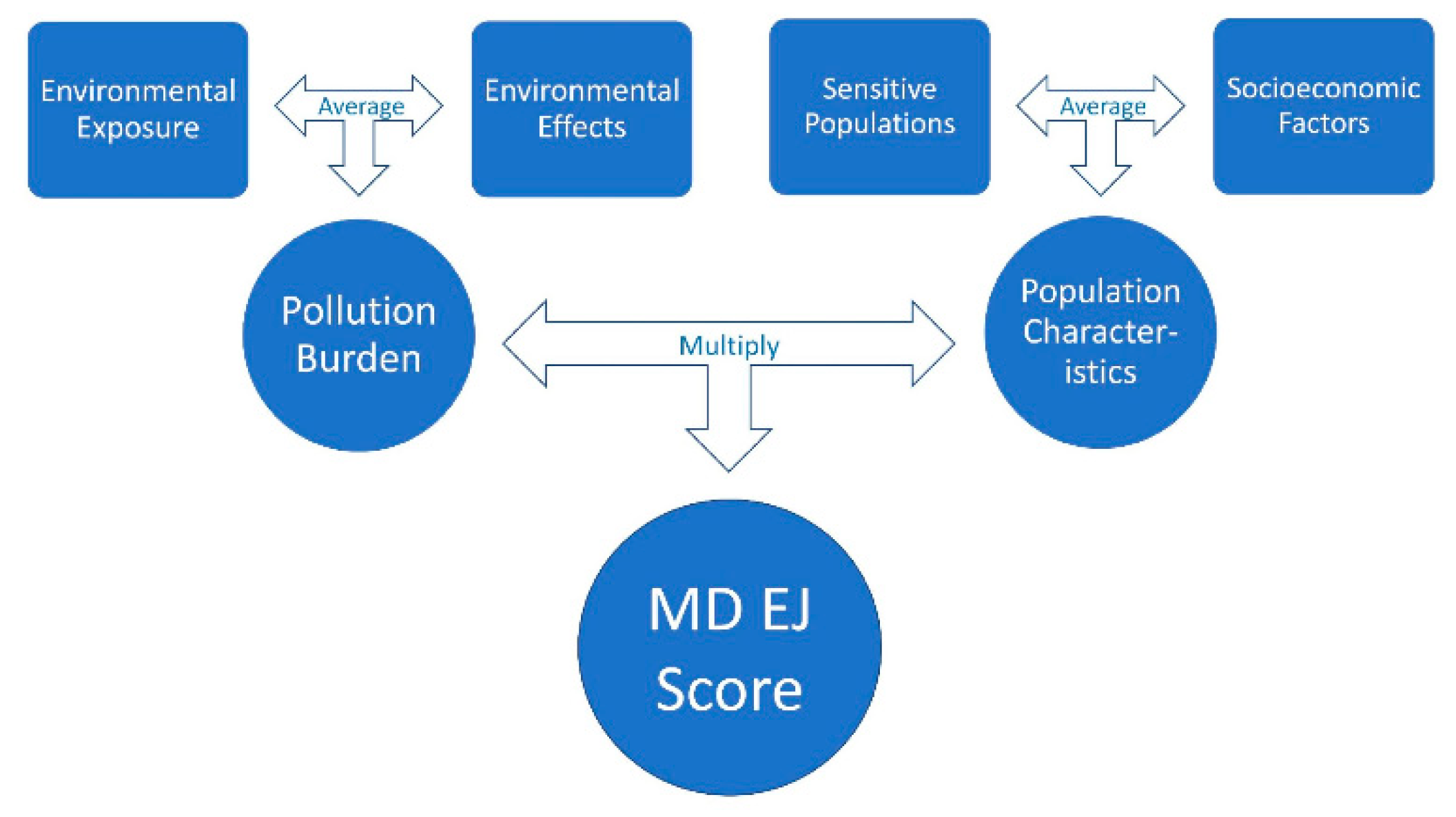

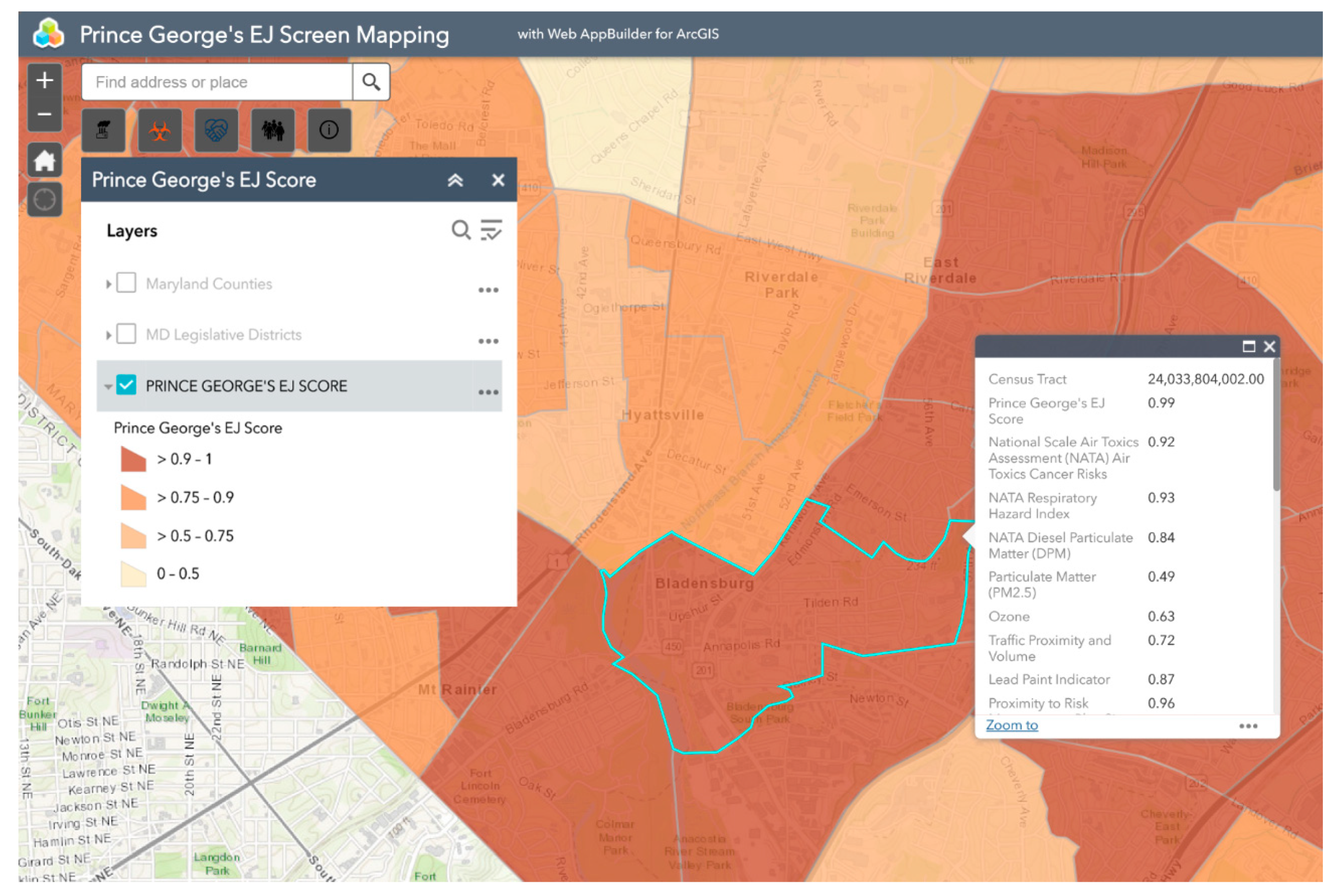
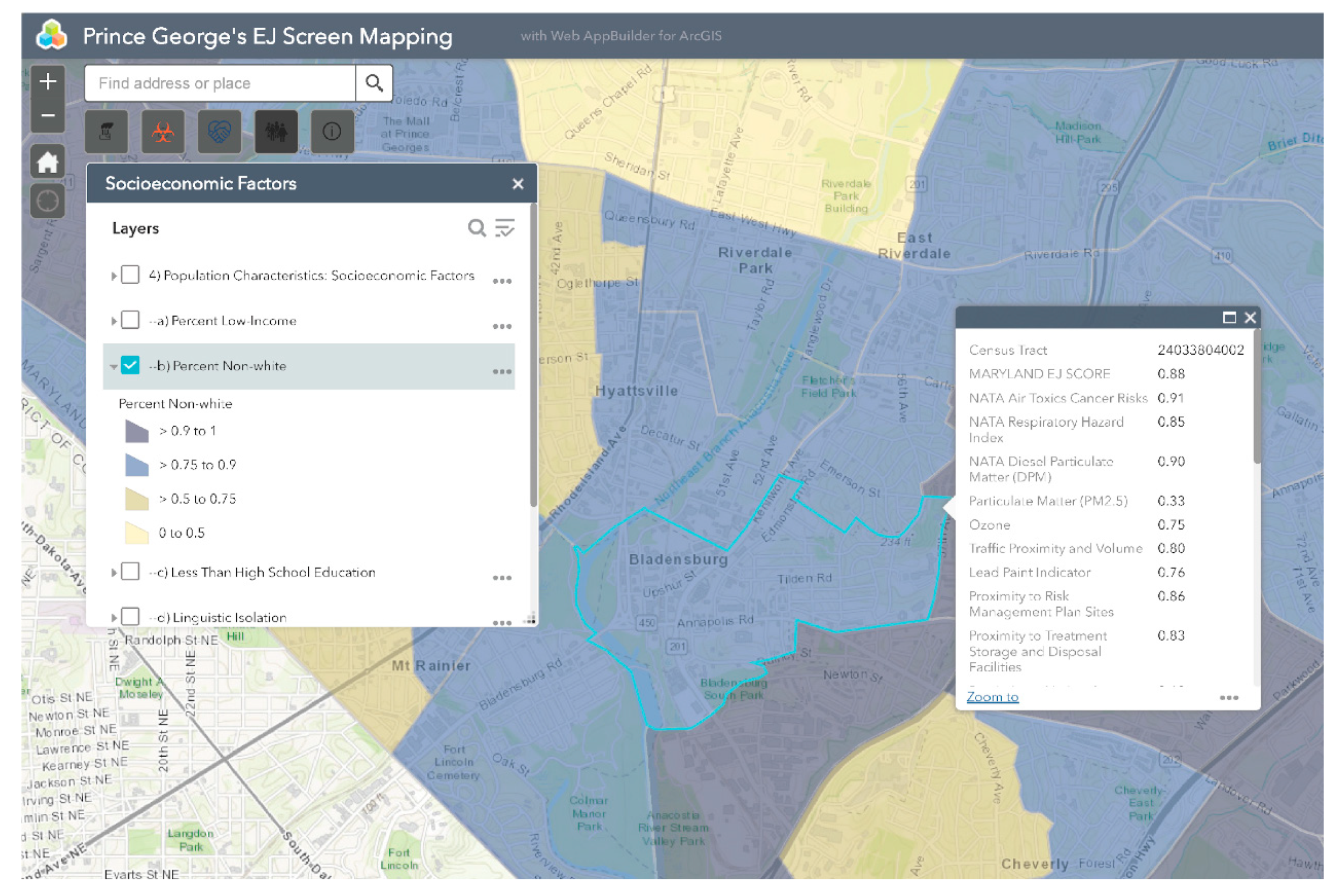
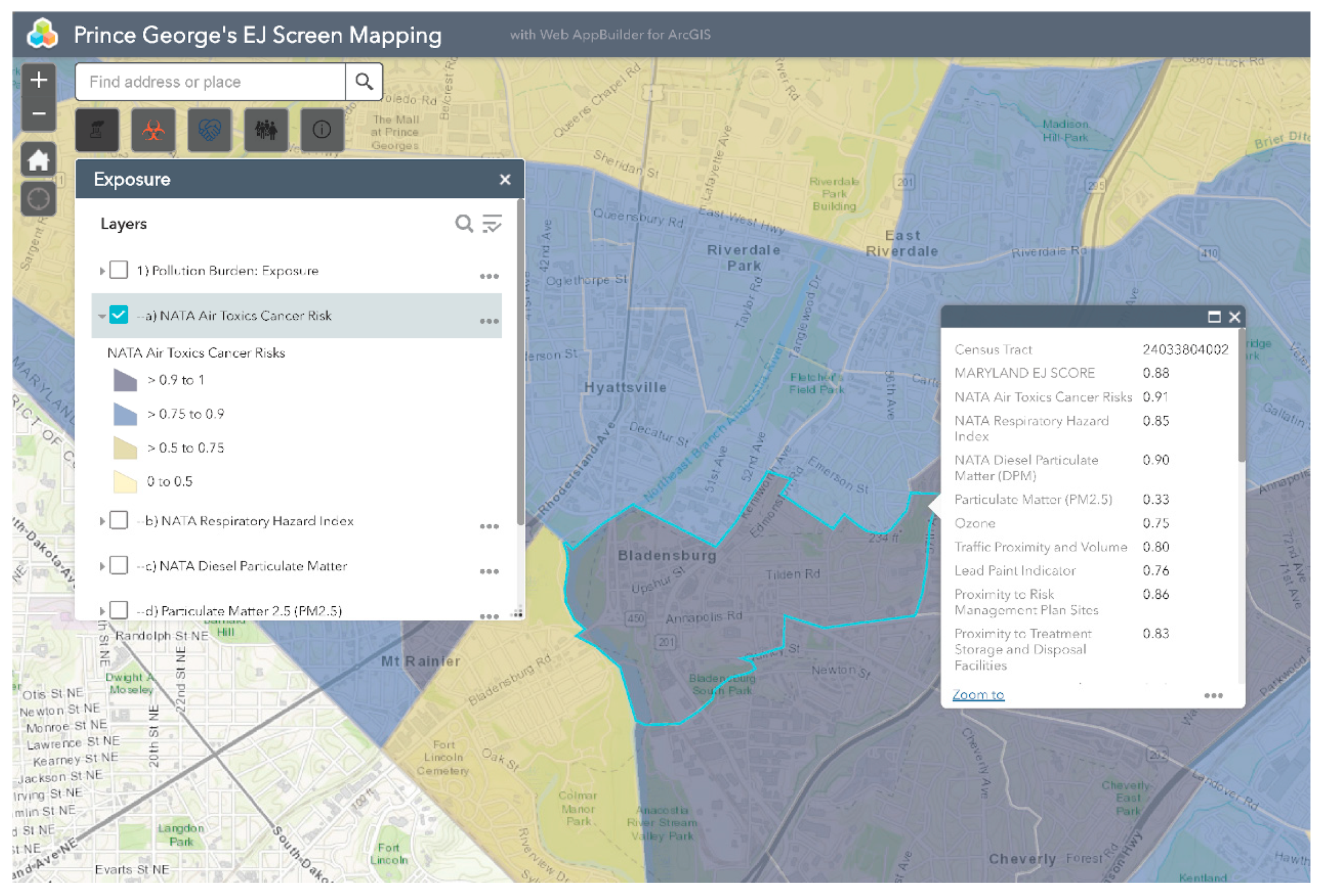
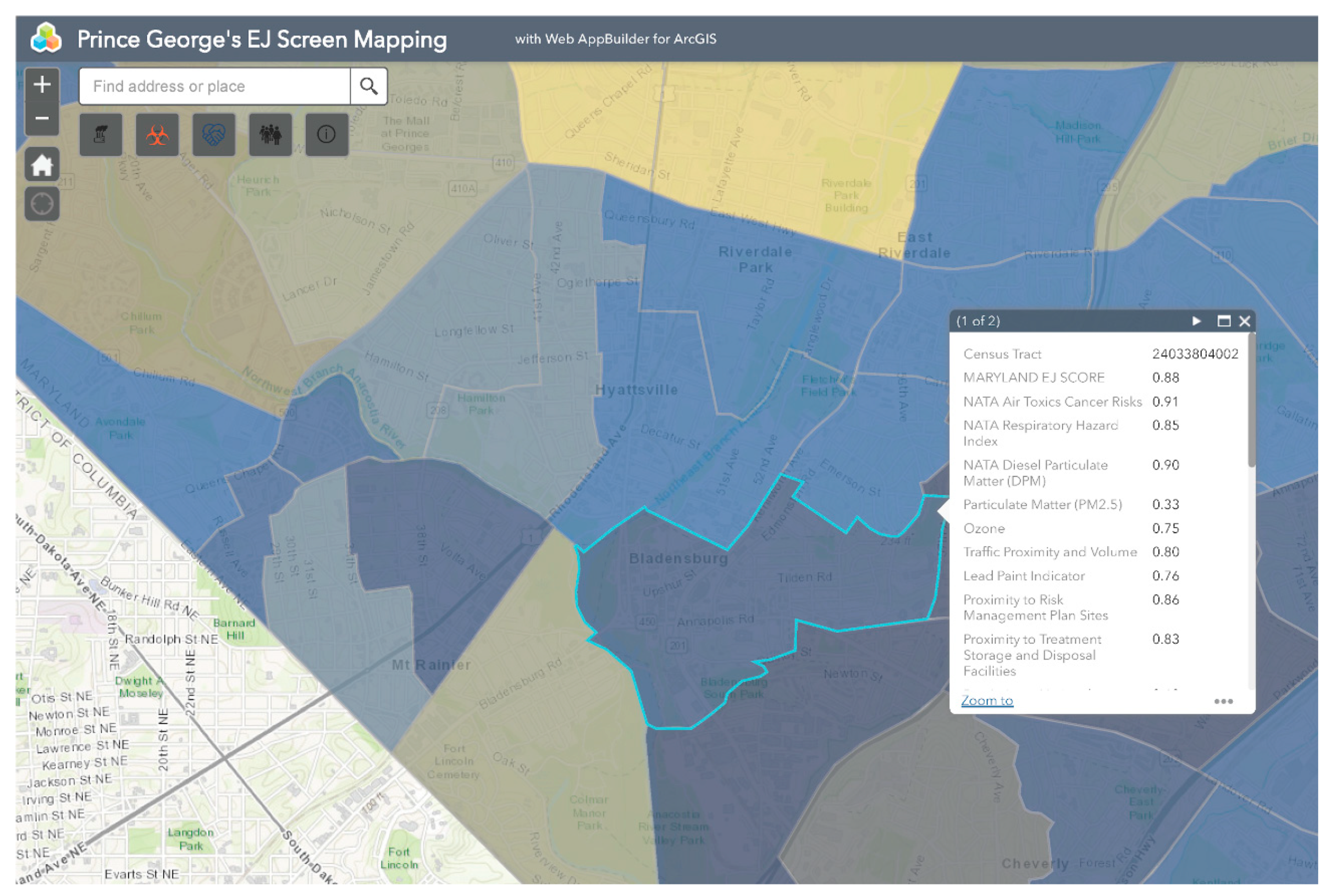
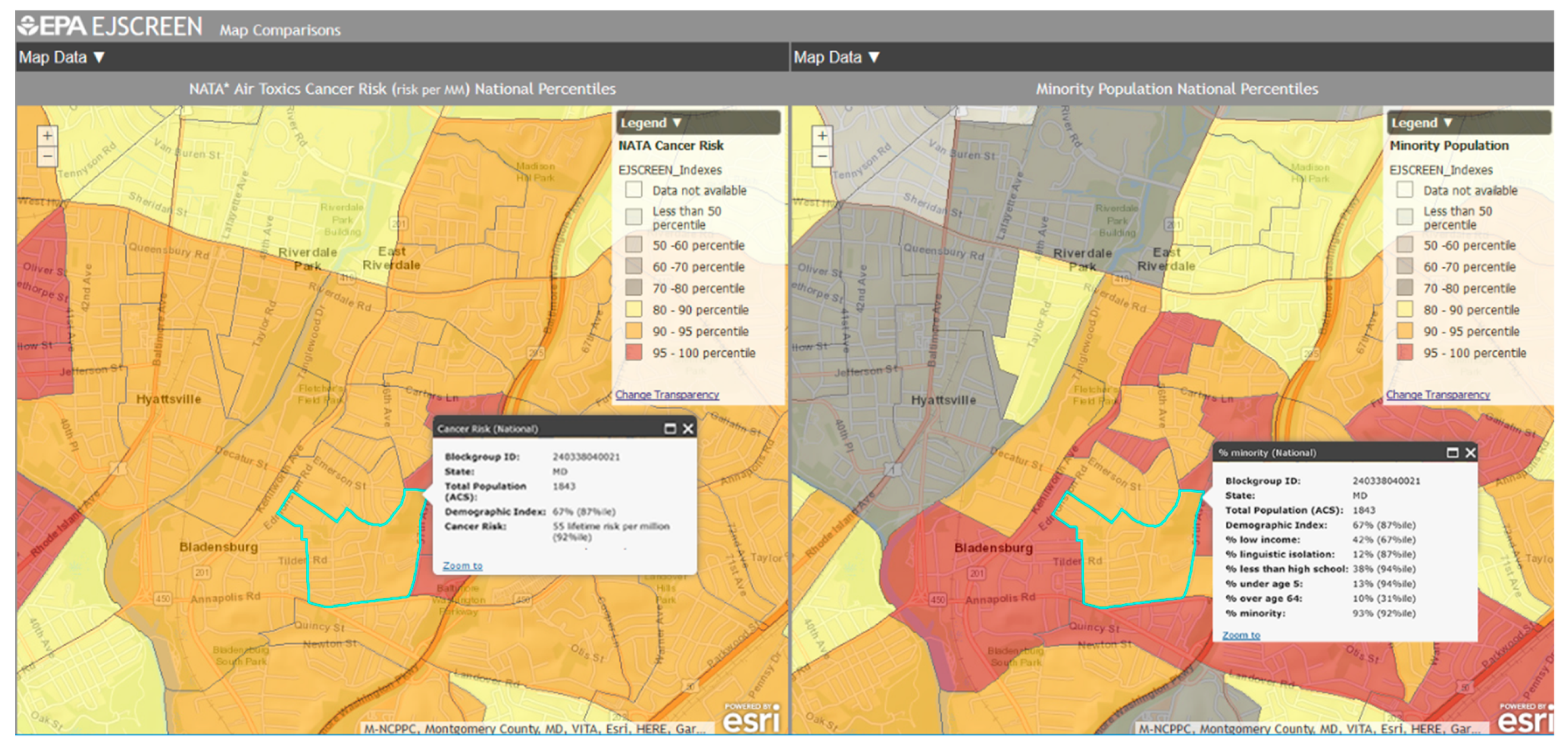
| Indicators | Description | EPA EJSCREEN | CalEnviroScreen | MD EJSCREEN |
|---|---|---|---|---|
| Pollution Burden: Exposure | ||||
| National Scale Air Toxics Air (NATA) Toxics Cancer Risk | Lifetime risk of developing cancer from inhalation of air toxins. Reported as risk per lifetime per million people [36]. | X | X | |
| NATA Respiratory Hazard Index | Air toxics respiratory hazard index. This is the sum of hazard indices for those air toxics with reference concentrations based on respiratory endpoints, where each hazard index is the ratio of exposure concentration in the air to the health-based reference [36]. | X | X | |
| NATA Diesel Particulate Matter (DPM) | Levels of diesel particulate matter in air. Reported as micrograms per cubic meter (µg/m3) [35,36]. | X | X | X |
| Particulate Matter (PM2.5) | Levels of particulate matter with a diameter of 2.5 micrometers or smaller in air. Reported as micrograms per cubic meter (µg/m3) [35,36]. | X | X | X |
| Ozone | Summer seasonal average of the maximum daily 8-hour concentration of ozone in air in parts per billion [35,36]. | X | X | X |
| Traffic Proximity and Volume | Count of vehicles (average annual daily traffic) at major roads within 500 meters or close to 500 meters, divided by distance in meters [35,36]. | X | X | X |
| Pesticide Use | Total pounds of selected active pesticide ingredients (filtered for hazard and volatility) used in production-agriculture per square mile, averaged over three years (2012 to 2014) [36]. | X | ||
| Drinking Water Contaminants | Water tested to contain one or more contaminants listed in ‘Update to California Communities Environmental Health Screening Tool’. Reported as yearly averages of chemical contaminant concentrations for each census tract [36]. | X | ||
| Toxic Releases from Facilities | Toxicity-weighted concentrations of modeled chemical releases to air from facility emissions and off-site incineration (averaged over 2011 to 2013) [36]. | X | ||
| Pollution Burden: Environmental Effects | ||||
| Lead Paint Indicator | Percent of houses built before 1960, which likely contain lead paint [36]. | X | X | |
| Proximity to Risk Management Plan (RMP) Sites | Count of RMP (potential chemical accident management plans) facilities within 5 kilometers or close to 5 kilometers, divided by distance in kilometers [36]. | X | X | |
| Proximity to Treatment Storage and Disposal Facilities (TSDF) | Count of TSDF (hazardous waste management facilities) within 5 kilometers or closest to 5 kilometers, divided by distance in kilometers [36]. | X | X | |
| Proximity to National Priorities List (NPL) Sites | Count of NPL/Superfund sites (polluted sites that pose a risk to human health and/or the environment) within 5 kilometers or close to 5 kilometers, divided by distance in kilometers [35,36]. | X | X | X |
| Proximity to Major Direct Water Discharges | Toxic concentrations in stream segments within 500 meters, divided by distance in kilometers (km). Standards modeled after Risk-Screening Environmental Indicators (RSEI) [36]. | X | X | |
| Watershed Failure | Percent of each census tract’s watershed that exceeds levels of phosphorus and/or nitrogen [39]. | X | ||
| Groundwater Threat | Nature and the magnitude of the threat and burden to groundwater safety posed by sites maintained in GeoTracker [35]. | X | ||
| Impaired Water Bodies | Contamination of streams, rivers, and lakes by pollutants which compromise the ability to use a body of water for drinking, swimming, fishing, aquatic life protection, etc. [35]. | X | ||
| Solid Waste Sites and Facilities | Solid waste landfills, composting, and recycling facilities [35]. | X | ||
| Population Characteristics: Sensitive Populations | ||||
| Asthma Emergency Discharges | Count of patients released from the hospital after being admitted for asthma or asthma-related distress [40]. | X | ||
| Myocardial Infarction Discharges | Patients released from the hospital after being admitted for a heart attack or heart attack symptoms [35]. | X | X | |
| Low Birth Weight Infants | Babies born weighing less than 5.5 pounds [35]. | X | X | |
| Asthma Emergency Visits | Patients admitted to the emergency room for asthma or asthma-related distress [35]. | X | ||
| Population Characteristics: Socioeconomic Factors | ||||
| Percent Non-White | Percentage of individuals who define themselves as any race/ethnicity besides non-Hispanic White [35,36]. | X | X | X |
| Percent Low-Income | Percentage of individuals whose household income in the past 12 months is less than two times below the federal poverty level [35,36]. | X | X | X |
| Less than high school education | Percentage of individuals 25 and older who lack a high school diploma [35,36]. | X | X | X |
| Linguistic Isolation | Percentage of households in which no one 14 years old and older speaks English "very well", or households which speak only English [35,36]. | X | X | X |
| Individuals under age 5 | Percentage of people under the age of 5 [36]. | X | X | |
| Individuals over age 64 | Percentage of people over the age of 64 [36]. | X | X | |
| Unemployment | Percentage of the population over the age of 16 that is unemployed and eligible for the labor force. Excludes retirees, students, homemakers, institutionalized persons except prisoners, those not looking for work, and military personnel on active duty [35]. | X | X | |
| Housing Burdened Low Income Households | Percentage of households in a census tract that make less than 80% of the HUD Area Median Family Income and paying greater than 50% of their income to finance housing [35]. | X | ||
| Indicator | Description | Data Source and Year |
|---|---|---|
| Pathogenic Infrastructure | Features of the built environment that increase a population’s vulnerability to chemical and non-chemical stressors leading to adverse health outcomes. For example, liquor stores, fast food restaurants, convenience stores, pawn shops, and payday lenders [41]. | American Society of Civil Engineers (ASCE), 2017 |
| Salutogenic Infrastructure | Physical, economic, natural, social, and spiritual features of the environment that foster health and nourish wellness. For example, hospitals, primary care providers, grocery stores, parks, recreational facilities, and churches [41]. | ASCE, 2017 |
| Tree Canopy Coverage | Layer of leaves, branches, and stems of trees that cover the ground when viewed from above. Refers to the quantity and quality of trees in a specific geographic area [42]. | Maryland Department of Natural Resources (DNR), 2017 |
| Brownfields | Refer to any area that is saturated by water, either permanently or seasonally (e.g., swamps, marshes, estuaries, lakes, rivers, etc.) Can include data from monitoring sites, the location and scope of restoration efforts from Maryland’s Non-Tidal Wetland Mitigation Program and the distribution of funding provided through the Federal Clean Water Act Section 319 (h) [43]. | USEPA, 2017 |
| Wetlands and Waterways | Refer to any area that is saturated by water, either permanently or seasonally (e.g., swamps, marshes, estuaries, lakes, rivers, etc.) [44]. Can include data from monitoring sites, the location and scope of restoration efforts from Maryland’s Non-Tidal Wetland Mitigation Program and the distribution of funding provided through the Federal Clean Water Act Section 319(h) [45]. | USEPA, 2017 |
| Health & Environmental Advocacy Groups | Studies have reported a strong, inverse correlation between social capital and health inequalities [46]. Local health and environmental advocacy groups promote access to social capital and give voice to marginalized members of the community [47]. | Maryland Environmental Health Network, 2017 |
| Grocery Stores | Number and location of grocery stores including Giant, Costco, Whole Foods, Safeway, etc. [48]. | North American Industry Classification System (NAICS), 2018 |
| Convenience Stores | Number and location of convenience stores including CVS, 7-Eleven, and gas stations [49]. | NAICS, 2018 |
| Liquor Stores | Number and location of stores selling alcohol [50]. | NAICS, 2018 |
| Zoned Industrial Area—I1 | Light intensity industrial zone. Manufacturing, assembling, or processing of refined goods [51]. | Prince George’s (PG) County.gov |
| Zoned Industrial Area—I2 | Heavy intensity industrial zones [51]. | PG County.gov |
| Parks | Number and location of federal, state, and municipal parks. Includes national parks, local parks, playgrounds, biking and walking trails, etc. [52]. | Protected Areas Database (PAD)-US, 2016 |
| Recreational Areas | Green spaces used for recreation. Includes soccer fields, baseball fields, tennis courts, basketball courts, golf courses, etc. [53]. | PG County Department of Parks and Recreation |
| Point Source Discharge | Any identifiable source from which pollutants are discharged. For example, a pipe, ditch, channel, tunnel, conduit, well, discrete fissure, container, rolling stock, concentrated animal feeding operation, or vessel or other floating craft. Agricultural stormwater discharges and return flows from irrigated agriculture are not included in this definition [54]. | EPA Clean Water Act (CWA), 1972 |
| Major Air Pollution Sources | Any source that emits 10 tons of any of the 187 toxic air pollutants listed in the Clean Air Act, or 25 tons of a mixture of air toxins, per year. There are multiple sources of pollution such as mobile (cars, trucks, and busses), stationary, (factories, refineries, and power plants), indoor (select building materials and cleaning solvents), and naturally-occurring sources (volcanic eruptions and forest fires) [55]. | EPA Clean Air Act (CAA), 1992 |
| Bladensburg Air Pollution Minor | Any source which emits, or has the potential to emit, regulated New Source Review (NSR) pollutants in amounts less than the major source thresholds [56]. | CAA, 1992 |
| Hazardous Waste Site | Any area which is contaminated by pollutants deemed dangerous or capable of having harmful effects on human health or the environment. More specifically, any area contaminated by chemicals on the F, K, P, and U lists, found in title 40, section 261, of the Code of Federal Regulations (CFR) [57]. | Resource Conservation and Recovery Act (RCRA), 1976 |
| Health Provider Shortage Area | A shortage of primary care and dental providers for the entire population or specific population groups within a defined geographic area [58]. | Health Resources and Services Administration (HRSA), 2016 |
| Supermarkets | Any establishment which retails a general line of food, such as canned, dry and frozen foods, fresh fruits and vegetables, fresh and prepared meats, fish, poultry, dairy products, baked products and snack foods. These establishments may also retail non-food products such as household paper products, toiletries, and non-prescription drugs [59]. | NAICS, 2012 |
| Limited Supermarket Access Areas | One or more contiguous census block groups where residents must travel significantly further to reach a supermarket than the, “comparative acceptable” distance that residents in well-served areas must travel [60]. | The Reinvestment Fund (TRF), 2013 |
| EPA Superfund Sites | Any land that has been identified by the USEPA as a candidate for cleanup because of hazardous waste contamination. These sites are placed on the National Priorities List (NPL) [61]. | The Comprehensive Environmental Response, Compensation, and Liability Act (CERCLA), 1980 |
| Public Schools | Public schools including elementary, middle, and high schools; charter schools; special centers [62]. | Prince George’s County Public Schools (PGCPS), 2018 |
| Railroads | Main lines such as spur lines, and rail yards, mass transit rail lines such as carlines, streetcar track, monorail or other mass transit rail and special purpose rail lines such as cog rail lines, incline rail lines, and trams [63]. | US Census Bureau, Department of Commerce, 2015 |
| Features | EPA EJSCREEN | CalEnviroScreen | MD EJSCREEN |
|---|---|---|---|
| Usability | |||
| User-Defined Search | X | X | X |
| User-Defined Base Map Options | X | ||
| User-Defined Location Markers | X | X | X |
| Zoom In/Out | X | X | X |
| Bookmark | X | ||
| Help Manual | X | X | |
| Functionality | |||
| Print Maps | X | X | |
| Share Maps | X | ||
| Create Maps | X | X | X |
| Create Score | X | X | |
| Create Reports | X | ||
| Display Statistics | X | X | |
| Download Raw Data | X | X | |
| Create Graphs | X | ||
| Create Tables | X | X | |
| Measure Function | X | ||
| Locate Function | X | X | X |
| Display Legislative Districts | X | ||
| Display County Lines | X | ||
| Mobile Version | X | ||
| Side-by-Side Maps | X | ||
| Overlay Maps | X | ||
© 2019 by the authors. Licensee MDPI, Basel, Switzerland. This article is an open access article distributed under the terms and conditions of the Creative Commons Attribution (CC BY) license (http://creativecommons.org/licenses/by/4.0/).
Share and Cite
Driver, A.; Mehdizadeh, C.; Bara-Garcia, S.; Bodenreider, C.; Lewis, J.; Wilson, S. Utilization of the Maryland Environmental Justice Screening Tool: A Bladensburg, Maryland Case Study. Int. J. Environ. Res. Public Health 2019, 16, 348. https://doi.org/10.3390/ijerph16030348
Driver A, Mehdizadeh C, Bara-Garcia S, Bodenreider C, Lewis J, Wilson S. Utilization of the Maryland Environmental Justice Screening Tool: A Bladensburg, Maryland Case Study. International Journal of Environmental Research and Public Health. 2019; 16(3):348. https://doi.org/10.3390/ijerph16030348
Chicago/Turabian StyleDriver, Aubree, Crystal Mehdizadeh, Samuel Bara-Garcia, Coline Bodenreider, Jessica Lewis, and Sacoby Wilson. 2019. "Utilization of the Maryland Environmental Justice Screening Tool: A Bladensburg, Maryland Case Study" International Journal of Environmental Research and Public Health 16, no. 3: 348. https://doi.org/10.3390/ijerph16030348
APA StyleDriver, A., Mehdizadeh, C., Bara-Garcia, S., Bodenreider, C., Lewis, J., & Wilson, S. (2019). Utilization of the Maryland Environmental Justice Screening Tool: A Bladensburg, Maryland Case Study. International Journal of Environmental Research and Public Health, 16(3), 348. https://doi.org/10.3390/ijerph16030348




